Article inspired by the thesis by Judy Epstein Buss, on the presence of the flute in the culture of indigenous peoples in North America. This study provides an important link to understanding traditional flute use and cad music in Native American cultures. This thesis was written in 1977.
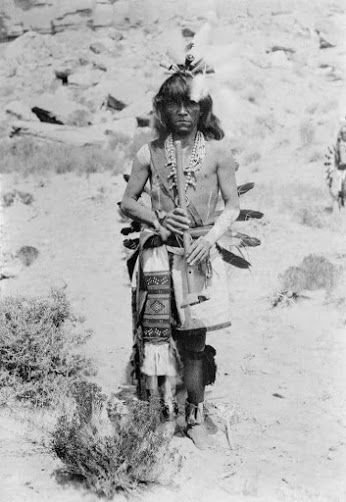
The flute played an important and unique role in Native American culture. With the drastic changes that these cultures have undergone since the 1930s (frequent displacement, diffusion and acculturation), many cultural traits have totally or partially disappeared, including records on the flageolet (wind instrument of the flute family). Consequently, this study is almost entirely based on material collected before 1935.
Apparently, the manufacture and performance of flutes was the privilege of a few among the indigenous peoples, therefore, many records about this instrument were lost. The same did not happen with the songs and stories, as they were passed down orally and shared by everyone, which helped a lot in their preservation.
The diversity among Native American peoples was so great, so many beliefs, stories, myths, rites, that sometimes within the same village there were reports and descriptions of their own culture in different versions. This study was a major challenge for the researcher to gain a thorough understanding of the place of the flute in Native American culture.
In folklore, stories, and records about Native American culture, flutes, whistles, and flageolets were vaguely mentioned. Due to the fact that those responsible for such records were not musicians, they did not take into account the difference between these instruments. And for this reason, in this study, the term “flute” will be used to refer to these instruments in general.
The Role and cad of the Flute in Native American Culture
Despite wide variation across cultures, the flute seems to be almost universally seen as a phallic symbol. Around the world, the flute is associated with fertility, birth, life and death and is used in a variety of rituals centered on these subjects.
Native American culture has produced a rich variety of mythologies and legends about the origin of the flute that demonstrate its supernatural power. The boundaries between myth and real life have become blurred. Thus, in rituals linked to the flute, a curious synthesis between the two can be witnessed.
The flute seemed to particularly represent male fertility in Native American culture. From mythology, as well as from ethnographies gathered across North America, it is evident that flute playing was restricted to men only. Even at the Pueblo Corn Milling Ceremony, a ritual performed only by women, reports describe a man playing the flute to accompany the women's singing and dancing.
In all the material examined, only one example was found citing a woman playing the flute and in this case, the purpose was to teach a boy to play it. This example is in the book “The history of the origin of the flute”. (Frances Densmore – 1867–1957)
The making of flutes did not appear to be restricted to men. Myths related that the flutes were made by shamans and dreamers, men and women, who, according to belief, had direct contact with the supernatural and were capable of attributing magical power to the flute. Numerous examples of women who made flutes can be found in mythologies, but there is no concrete historical evidence about this role of women in the universe of flutes of the Native peoples of North America.
The legends illustrate themes such as: the nature of the magical powers linked to the flute, the power that this instrument has to control the weather, to attract women, in addition to its use as a means of transport.
An example that especially brings out the magical power attributed to the flute is found in Apache myths and tales. The flute becomes a means of transportation, a fact that Goddard says:
“…is one of the recognized methods of rapid transport” (Goddard 1919)
In various versions of the story “The Myth of Creation”, a man who was looking for his missing wife used the flute to travel through the mountains:
“He set out, traveling with a blue flute that had wings… he went all the way around the edge of the world” (ibid)
Many myths addressed themes related to the enchantment powers of the flute, which was used as an instrument of seduction from men to women.
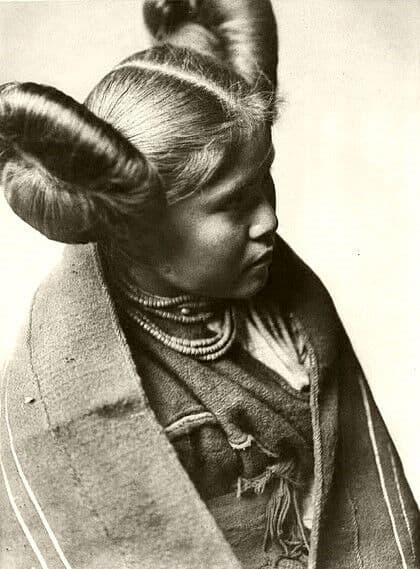
Fertility in Nature
In areas where corn is cultivated, there are beliefs that relate the symbolism of fertility and well-being with the symbolism of the flute. Writer Carlos Castaneda observed that around 1541, it was common for the use of flageoletes in the Corn Milling Ceremony among the Tewa Pueblos (The Tewa are North American indigenous peoples who spoke the Tewa language and share the Pueblo culture. Their lands hometowns are near the Rio Grande in New Mexico, north of Santa Fe). These rituals were performed by women, who used the sound of whetstones, dances and songs to compose their ceremony, but the interesting thing was to identify the presence of a flageolet being cad by a man sitting at the door (Hammond-GP 1940).
A further example of the close relationship between the flute and the maize, dating to a later period, can be found in a study by AM Stephen of an initiation ceremony held at the Hopi Flute Society:
“When a youth of this people is brought to know the altar of the flute for the first time, he must bring a handful of flour as an offering to the man he has chosen as 'priest' or 'master.' The 'priest' throws the offering onto the altar... On the fourth night of the ceremony, the novice is initiated and receives the ear of corn, which symbolizes his protective 'mother', and he holds this ear during the entire chant... Later this ear is held cad in the house where this young man lives with his family. It ensures good food and health for the body, which is why a symmetrical ear is always chosen” (Stephen 1936).
The Blue and Drab societies, which are now extinct, played a very important role in Pueblo culture. One of the main duties of these societies was to pray for rain and fertility, as well as for warm weather and good harvests. As the Pueblo Indians mostly live in a desert environment, the absence of rain was a threat to their physical existence. Thus, much of the rich ceremonialism of the pueblos revolved around this concern. One of the most important events that took place in Pueblo culture was the Flute Ceremony, which took place in August. Ceremony and mythology are intimately connected. Secret rites were performed in the ancestral halls of this society, these ceremonies were not performed in the kivas (Kivas are large, circular, underground rooms used by Pueblo people for their ceremonies), where most other ceremonies were performed. The precise details of this ritual were known only to the priests who were the main performers of the ceremony and responsible for its transmission to succeeding generations of priests. The flute altar was a shrine covered with designs and a large number of items full of symbolism. On the flute altar was depicted the image of the Locust (Grasshopper, Kokopelli), the hunchbacked flutist known throughout the Southwest as the symbol of "healing" in flute society. This intriguing figure is linked to warm weather, fertility and even more to bravery. The various roles assigned to this character cover many aspects of life: fertility, life, climate control for heating, rainfall, good harvests, and war.
Among the Fox Indians, the flute was also a component of the package of "cures" through the White Buffalo Dance. Dispelling storms is included among one of the many functions of this ritual.
It is interesting to note that the number four is always related to the flute and its supernatural cad in rituals and myth. This relationship is expressed in many ways, such as in ceremonies where participants circle a place or object four times, a certain action is performed by four people at different points in a ritual, or some aspect or procedure that lasts four days. In addition to being present in the most diverse forms in myths linked to flutes.
The Visual Appearance and Structure of the Flute
The visual appearance of the flute is an integral part of its symbolic role. However, due to the dearth of material on this aspect, it is difficult to gain a sufficient understanding of the variety of design and color of flutes in Native American cultures.
Among the main factors that determine the potential of a flute, we have the number of holes, which in North American Indian flutes are usually four to six. There are also flutes with three and seven finger holes, as well as some with extra holes in the bottom of the tube. But the evidence for the right number of holes is very vague. However, it can be speculated that the number of holes in some flutes is determined by symbolic rather than musical reasons. Since four fingers are most common, it is likely that the number four, again, plays a symbolic role. In the myth “The Origin of the Flageolet” from the Mandan and Hidatsa villages. Grandma, (character in the tale) who made a flute from a sunflower stalk, explains that “the seven finger holes represent the seven months of winter”.
Some flutes had holes added at the bottom end of the tube. As with some Chinese flutes, these holes were not used for playing. It is not clear whether these extra holes were meant for decoration or had some other function. It is not improbable, however, that some Indian villages were influenced by the Chinese. Merriam mentions the presence of Chinese influence in the latter part of the 19th century, when many Chinese came to western Montana. Flutes with these holes added can be found in various villages.
The distance between the holes appears to approximate the size of the maker's hand and fingers or those for which a specific flute can be made. Merriam describes how a Flathead Indian flute maker drills the holes: “…the craftsman places his fingers in the hollow tube in what appears to be the proper position and burns the holes in the wood…”
The issue of distance between finger holes needs further study. The holes on many flutes, especially threes and fours, are equidistant. On a six-hole flute, there are usually two groups, cad consisting of equidistant holes. In another example, Densmore talks about a Yuman flute maker, Captain George: “he marked places for three finger holes where his finger rested most conveniently”
In her book “The American Indians and Their Music”, Frances Densmore briefly discusses the question of the position of the finger holes: “The Indians in all the villages questioned by the writer said that the finger holes in the flute are conveniently spaced to the flutist's hand. Flute sizes and construction material can vary greatly within a village, many different types of wood are used including cedar, juniper, elderberry, reed and so on. Some less common woods used are sunflower stalk, dried wild parsnip reeds. Other materials used: pottery (Pueblo) gun barrel (Apache) red pipestone (Sioux).
Color and design are among the most revealing visual aspects of the connection between the flute and its symbolic role. A large number of flutes described or collected by ethnographers and ethnomusicologists were painted in a variety of colors. Some colors, such as red, pink, black, yellow and green, are particularly common. Colors are cad to the flutes by staining or drawing specifically symbolic figurations, such as arrowheads, zigzags (depicting lightning), the water serpent with horns, and stars. Colors have a wide and complex range of connotations. Cad color can be linked to certain aspects of life and the universe. All directions in the world, for example, are represented by colors.
Whistle with the end carved in the shape of a bird's head. The sound is generated by a current of air hitting the sharp end of a broken piece of feather placed cad the opening in the side of the tube. These whistles are used in the Crane's ceremonial dance.
Some of the geometric designs mentioned above are burnt into the wood so the black designs stand out against the lighter color of the wood. Another widespread tradition is the ornamentation of flutes with animal effigies. A Papago flute in the collection of the Metropolitan Museum of Art in New York ends with a bird's beak. The courtship flute of the Sioux has a bird's head. The Great Twisted Flute of the Sioux is ornamented with the effigy of a horse and painted red on the inside of cad hole. An Oglala flute on display at the Metropolitan of Art in New York is decorated with a carved rabbit. At the Heye Foundation's Museum of the American Indian in New York, Cheyenne and Winnebago flutes on display, complete with bird heads.
In the cad Native American culture, animals symbolize certain aspects of life or attributes, such as bravery, successful hunting, and wealth. It is therefore not surprising to find animal effigies carved or mounted on flutes. Other frequently used ornamental and ceremonial devices include beads, shells, feathers, glass, metal slivers, or even the attachment of quena medicine pouches.

The foregoing discussion of the different elements that affect flute construction and appearance supports the assumption that non-musical concepts greatly influence flute making. However, there is clear evidence that musical criteria also play an important role:
When analyzing the songs cad through the flute, it is noticed that there is, in general, a uniform system in the musical style including scales. This probably would not have existed if its construction were based entirely on non-musical considerations. The strongest evidence that flute makers were concerned with the tones produced by their instruments is the fact that on many flutes a tuning block was cad to control intonation. A series of flutes to which a tuning block is attached are on display at the Museum of the American Indian in New York. The flutes in this collection with tuning blocks include the Blackfoot, Semiole and Winnebago.
Throughout this study, we can perceive the strong presence of the flute in the culture of most indigenous peoples of North America and all its relationship with the sacred universe of these peoples. Demonstrating that all the variations present in these instruments, whether through the material whose instruments are made, number of holes and even the painting and finishing, all these characteristics are somehow related to the supernatural beliefs or habits of the people.
References:
Cover art: cidolart
- The Flute and Flute Music of the North American Indians
- Tewa
- Kiva – Ancestral Pueblo Ceremonial Structures
- Winnebago, Native American Flute
- Whistles Native American – 19th Century Oglala Lakota, Sioux peoples



Native Flute Blog
Complete Breathing, Vagus Nerve and Playing Flutes
3 Comments
View morejan
Breathing and Flute in Chinese Medicine
View morejan
Schumann resonance
1 comment
View morenov
Rumi – Masnavi: The Lament of the Bamboo Flute
1 comment
View moreago
The boy and the flute – Lenda Nambiquara
View moreMay
History of Pan
1 comment
View moreMay
The Origin of the Fife
View moreten
The Power of Breath
2 Comments
View moreten